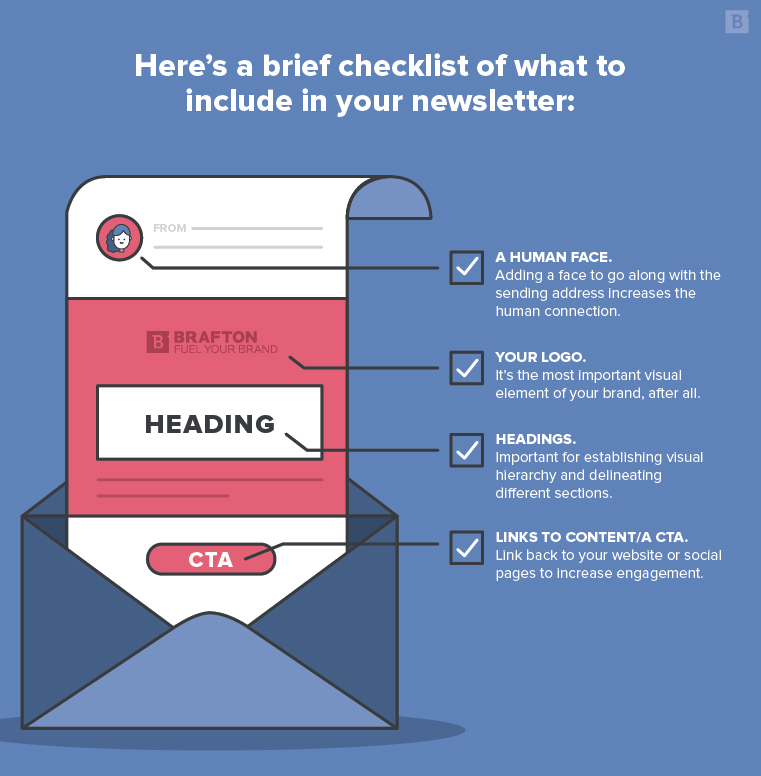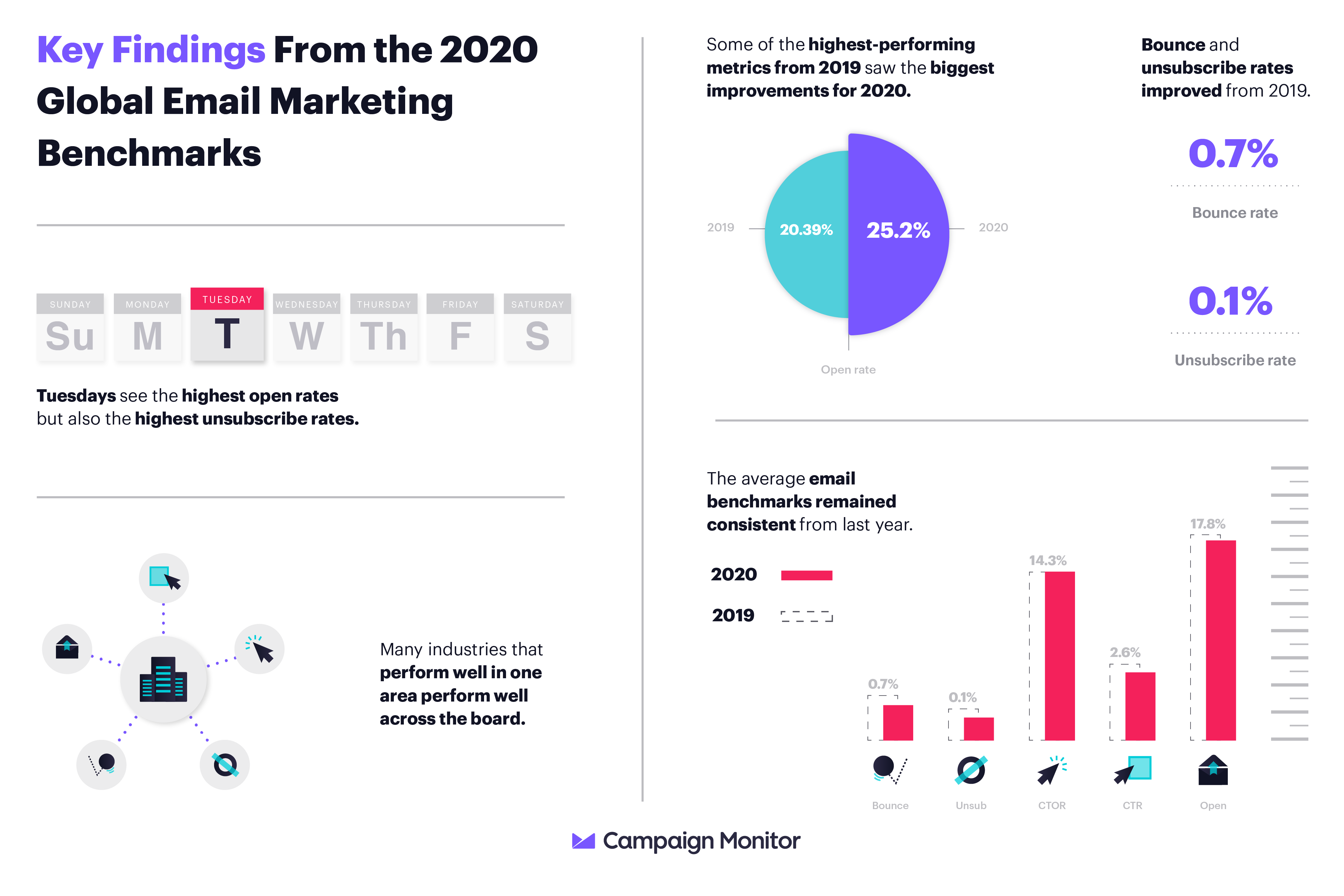Read this if you’re thinking about scaling back on a particularly extensive email campaign and condensing your high-value assets into a monthly newsletter instead of overburdening your contacts’ inboxes.
It’s not hard to find examples of great email newsletters, and while newsletter design can seem intimidating at first, with careful planning and the right tools, you can craft the kinds of updates that will leave your email recipients looking for more.
What Is a Monthly Newsletter?
A monthly newsletter is an opportunity to update your subscribers with useful information about your industry as well as upcoming events and current promotions.
Ideally, this email will be an integral component of your overall marketing plan, which should also include a steady stream of user-oriented content development. You will want to regularly create and publish new blog posts, informational videos and downloadable assets like eBooks and white papers in order to produce a great email blast that’s packed with valuable links and information.
Creating a monthly newsletter requires you to wow your readers without overwhelming your staff or your recipients by operating at an unsustainable pace. Consistency is key if you want to drive engagement.
Why Publish a Newsletter Monthly?
Engagement is what it’s all about.
Publishing a newsletter every month gives your prospects something to anticipate without feeling like they’re being tasked with additional inbox upkeep or excess digital clutter.
This isn’t to say that you can’t augment your newsletter sends with, say, a follow-up about an upcoming event, but those one-off emails should be short and targeted toward audience segments that are more likely to attend.
In other words, if your subscriber is busy, and you can afford to be patient, sticking to a monthly cadence for emails means your users will be less likely to opt out, especially if they feel that they’re receiving relevant content.
This last part is crucial, so at the risk of repeating ourselves, we’re going to hammer it home one more time here:
To produce great content, you have to share information that your readers find valuable.
Subscribe to
The Content Marketer
Get weekly insights, advice and opinions about all things digital marketing.
Thank you for subscribing to The Content Marketer!
What About Sending Weekly or Quarterly Email Newsletters?
Of course, each audience will respond best to a slightly different newsletter frequency. The key is to find the cadence that works best for your specific audience.
Weekly:
A weekly newsletter could ensure that your target audience keeps your company in mind if:
- You already have a loyal subscriber base of people who favor your brand.
- You offer a subscription service, and you want to make sure that users stay involved.
- Your flagship product line consists of regularly purchased consumer goods.
You may also wish to increase the pace at which you send emails if your followers need access to more timely updates about service changes due to rapidly evolving circumstances. For instance, the COVID-19 pandemic forced many businesses to update their operations while ensuring that their communications strategy could keep pace with the changes.
If you do shift from a monthly newsletter to a weekly roundup, make sure that you have the bandwidth to maintain the quality of information your subscribers have grown to expect. You don’t want to risk having users hitting unsubscribe because you’ve gone from delivering valuable content to a slapdash compilation of unimportant updates.
Quarterly:
On the other hand, a quarterly newsletter could be beneficial for organizations that need to keep their readers periodically apprised of what’s going on throughout the year while, otherwise, the sender can rest assured that their audience will remain committed to the group without additional nudges.
Examples of groups for which a quarterly newsletter may be sufficient include:
- Advisory boards.
- Internal stakeholders.
- Clients with multiyear contracts.
How Do You Create a Monthly Newsletter?
To create a newsletter each month, you’ll want to follow these four simple steps:
- Produce valuable, high-quality, targeted content.
- Draft, revise and finalize a subject line that encourages high click-through rates.
- Design a user-friendly interface that’s optimized across multiple platforms.
- Schedule and deploy your valuable monthly newsletter to produce optimal engagement.
Let’s explore each of these steps in-depth so you know exactly how to create a monthly newsletter that your readers will want to open.

1. Regularly Produce Valuable, High-Quality, Targeted Content.
A typical monthly newsletter will incorporate interesting content like:
- Your most recent blogs.
- Pertinent news roundups.
- Social media exchanges.
- Testimonials and case studies.
- New information about products and services.
Do you have to produce each of these items in-house?
No.
Look for partners in your space that may be willing to collaborate on content development or schedule a time each week to search for outside resources your readers will love. If you provide SEO services, you can collaborate with free resources like SEOFOMO to deliver valuable news and insights about this particular industry.
Of course, if you can put your own spin on the material by creating a customized, branded asset like a blog or an eBook, that’s even better, but focus first on providing value for your readers.
Then, it’s time to write your email newsletter. Create short, concise copy that maintains the established tone of your brand while speaking in a voice that feels approachable and familiar. Make the headlines and body of your email skimmable and ensure that your audience feels like their time has been respected. From the technical point of view, make sure to use a DMARC record generator to ensure your emails are authenticated and sent properly.

2. Draft, Revise and Finalize a Subject Line That Encourages High Click-Through Rates.
By closely monitoring the results of your different sends, you’ll begin to get a feel for which subject lines work best for your particular audience.
To get started, here are some elements to keep in mind that could impact open and click-to-open rates:
- Word choice.
- Use of capitalization.
- Incorporation of numerals.
- Streamlining your character and word count.
- Leveraging emojis.
That last point may be situationally dependent. While emojis might be perfectly at home coming from a brand that has a somewhat cheeky identity, more straightforward businesses will want to forgo such informalities.
Above all, though, here’s the No. 1 rule of email newsletter subject lines:
Do not mislead your audience.
That’s called clickbait, and just thinking about it is enough to send us into panic mode.
3. Design a User-Friendly Interface That’s Optimized Across Multiple Platforms.
For this next step, whether you have an in-house designer or you’re a DIY bootstrapper, knowing your way around a user-friendly set of email marketing tools will do wonders for your newsletter.
Take the time necessary to develop a comprehensive newsletter template that you can replicate each month. Rest easy knowing it will already be optimized for display on mobile as well as various desktop email clients like Outlook and Gmail.
Tools we recommend checking out:
- Mailchimp.
- Constant Contact.
- HubSpot.
- Marketo.
4. Schedule and Deploy Your Newsletter for Optimal Engagement.
Data indicates that emails sent on Tuesday may experience the highest open rates, but they also see more people selecting unsubscribe than communications sent during the rest of the week.

Thursdays still beat out the rest of the week for open rates, and they see about as many people choosing to unsubscribe as any other day.
Overall, conventional wisdom says to avoid Friday through Monday.
That said, no amount of baseline metrics can substitute for self-examination. Carefully monitor your own email engagement rates to find out what day of the week works best for your particular audience.
Also, use your email marketing automation software to select an ideal time of day to send your newsletter. Avoid sending it too early or too late during the business day, and make sure to coordinate arrival based on the recipient’s local time zone.
What Makes a Successful Newsletter?
Successful newsletters will look different from one company to the next. Some criteria for claiming a win could include:
- Moving prospects further down the sales funnel by driving user engagement.
- Improving conversion rates for contacting the company or filling out forms to download gated content.
- Raising open rates and social sharing, indicating that the company is respected as a thought leader.
Your monthly newsletter may be intended to accomplish all of these goals simultaneously, but conversions will likely play an important role since they demonstrate tangible benchmarks on the road to more sales. So when you think about how to determine success for your business, here’s the important part: You can have the slickest newsletter design in the world, but if you’re not crafting email content to maximize conversions, it won’t matter.
Looking for an initial benchmark to measure engagement? The overall open rate across all industries was 21.33% on average, according to recent research.
If you need more readers to open your newsletter and complete conversions as part of your quest to drive traffic to your website and acquire more clients, keep these pointers in mind:
- Write emails that are easy to read, from the subject line to the body copy. Use short, direct sentences.
- Make sure each new blog post is relevant to your audience. Don’t lose sight of relevance and value as you endeavor to create content that’s optimized for search.
- Make your calls to action (CTAs) easy to find, simple to follow and intriguing. There should be a reasonable incentive for any conversion you expect from your users.
The Monthly Email Newsletter Recipe for Success: Lower Frequency, Higher Value and Better Results
When we say less is more, what we really mean is that even when you share free content, your emphasis should be on providing a strong value proposition for your existing customers and potential clients.
Every moment they spend on your monthly email newsletter is a vote of confidence in what you’re providing for them.
As an email marketer, you know how fickle readers can be, and when they feel like they’ve been misled or that their time is wasted, they’ll have no problem hitting unsubscribe, a fate worse than deleting the email unread.





